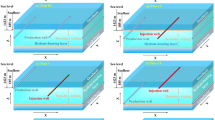Abstract
Due to the severe winter climate conditions in northern China, gas wells and pipelines are at high risk of gas hydrate blockage. In order to ensure stable gas supply in winter, the required Methanol injection concentrations are as high as 30–60 wt% of water rates in Daqing gas wells. As increasing in the water-gas ratio, large quantities of Methanol are injected into wells through Methanol injection lines. However, there are some drawbacks in the current Methanol injection process, including huge Methanol consumptions, high operating costs, large loads of the pum** system, and long residence time of Methanol in injection pipelines. In addition, large amounts of Methanol injected into well bottom will inevitably affect the liquid entrainment capacity of gas wells. Therefore, to reduce Methanol injection quantities and improve the inhibitor injection efficiency, this paper carries out a research and field test on the intelligent injection technology of mixed natural gas hydrate inhibitors. The Kinetic Hydrate Inhibitor PVCap and Methanol are mixed to study methane hydrate formation temperature under the operating pressure of 5 MPa and rotating speed of 20 r/min. The results show that the critical temperature of hydrate formation can be reduced to 0.89 ℃ and induction time can be extended to 6330 s when 1 wt% PVCap and 5 wt% Methanol were mixed, which meets the safety transportation requirements between gas wells and gathering stations. Meanwhile, an intelligent inhibitor injection device has been developed, which can inject low dose mixed inhibitors continuously and can automatically adjust the injection rates by real-time monitoring and analyzing wellhead temperatures, pressures, and water productions. The technology has been tested in a hydrate-plugged gas well X. Before the test, the well cannot be opened, the opening time was 0 in 2018, which affected the annual production capacity of 450 × 104 m3. In the field test, the injection rates of the mixed inhibitors are 0–15 L/h, gas well X resumes production successfully. Compared with the traditional process, Methanol consumption is reduced by more than 80%. The manual replenishment cycle of inhibitors can be up to 15 days, and the maintenance workload is reduced by 93.3%, which is of great significance to the construction of the digital gas field in Daqing Oilfield.
Access this chapter
Tax calculation will be finalised at checkout
Purchases are for personal use only
Similar content being viewed by others
References
Fu, W., Wang, Z., Zhang, J., Sun, B., et al.: Methane hydrate formation in a water-continuous vertical flow loop with xanthan gum. Fuel 265, 116963 (2020)
Talaghat, M.R.: Experimental investigation of induction time for binary mixtures during gas hydrate formation in the simultaneous presence of the PVP and L-Tyrosine as kinetic inhibitors in a flow mini-loop apparatus (2013)
Sergey, S., Zachary, A., Sanjee, J., et al.: Measurements to characterize the pluggability of crude oils. In: Proceedings of the 7th International Conference on Gas Hydrates (2011)
Sloan, E.D., Koh, C.A., Sum, A.K.: Hydrates: state of the art inside and outside flowlines. J. Petrol. Technol. 61(12), 89–94 (2009)
Gbaruko, B.C.: Asphaltenes, oil recovery and down-Hole upgrading in the Nigerian petroleum industry. In: Abstracts of Papers of the American Chemical Society, vol. 228, p. 1155 (2004)
Glénat, P., Saha, P., Macpherson, C., et al.: Field tests results of production inside hydrate P&T zone using new hydrate monitoring instruments. In: Offshore Mediterranean Conference and Exhibition. Offshore Mediterranean Conference (2015)
Lovell, D., Marek, P.: Hydrate inhibition in gas wells treated with two low dosage hydrate inhibitors. In: SPE Gas Technology Symposium. Society of Petroleum Engineers (2002)
Odutola, T.O., Onyekonwu, M.O., Ikiensikimama, S.S.: Effect of N-Vinylcaprolactam on hydrate inhibition in gas dominated system. In: SPE Nigeria Annual International Conference and Exhibition. Society of Petroleum Engineers (2016)
Guan, H.: The inhibition of gas hydrates and synergy of the inhibiting molecules. In: International Oil and Gas Conference and Exhibition in China. Society of Petroleum Engineers (2010)
Kelland, M.A.: History of the development of low dosage hydrate inhibitors. Energy Fuels 20(3), 825–847 (2006)
Budd, D., Hurd, D., Pakulski, M., et al.: Enhanced hydrate inhibition in Alberta gas field. In: SPE Annual Technical Conference and Exhibition. Society of Petroleum Engineers (2004)
Menendez, C.M., Jardine, J., Mok, W.Y., et al.: New sour gas corrosion inhibitor compatible with kinetic hydrate inhibitor. In: IPTC 2014: International Petroleum Technology Conference vol. 2014, no. 1, pp. 1–9 (2014)
Md Zain, Z., Yang, J., Tohidi, B., et al.: Hydrate monitoring and warning system: a new approach for reducing gas hydrate risks. In: SPE Europec/EAGE Annual Conference. Society of Petroleum Engineers (2005)
Clark, L.W., Anderson, J.: Development of effective combined kinetic hydrate inhibitor/corrosion inhibitor (KHI/CI) products. Paper, vol. 4020, pp. 13–16 (2006)
Carpenter, C.: Locally sourced, ecofriendly hydrate inhibitor effective in simulated offshore environment. J. Petrol. Technol. 71(09), 96–97 (2019)
Zang, X.Y., Liang, D., Fan, S.S.: Effect of 3A molecular sieve on THF hydrate decomposition. J. Refrig. 28(6), 29–34 (2007)
Hu, J.: Synthesis, performance and application of Kinetic Hydrate Inhibitors. South China University of Technology (2012)
Author information
Authors and Affiliations
Editor information
Editors and Affiliations
Rights and permissions
Copyright information
© 2021 The Author(s), under exclusive license to Springer Nature Singapore Pte Ltd.
About this paper
Cite this paper
Li, Q. et al. (2021). Research and Field Test on Intelligent Injection of Mixed Natural Gas Hydrate Inhibitors. In: Lin, J. (eds) Proceedings of the International Field Exploration and Development Conference 2020. IFEDC 2020. Springer Series in Geomechanics and Geoengineering. Springer, Singapore. https://doi.org/10.1007/978-981-16-0761-5_151
Download citation
DOI: https://doi.org/10.1007/978-981-16-0761-5_151
Published:
Publisher Name: Springer, Singapore
Print ISBN: 978-981-16-0762-2
Online ISBN: 978-981-16-0761-5
eBook Packages: EngineeringEngineering (R0)




